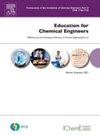Advancing chemical engineering education: Amplifying active learning with Wooclap’s innovative pedagogical techniques
IF 2.3
2区 教育学
Q1 EDUCATION, SCIENTIFIC DISCIPLINES
引用次数: 0
Abstract
The integration of Information and Communication Technologies (ICT) into university education has evolved into Learning and Knowledge Technologies (LKT), enhancing teaching and learning practices. In this scenario, Audience Response Systems (ARS), such as Wooclap, are effective tools for fostering student engagement through interactive methods like real-time questions, surveys, and games. In this study, Wooclap was implemented in 12 Chemical Engineering courses from 7 different degree programs, with a potential audience of 629 students. A total of 277 students and 10 instructors participated in the evaluation, which measured perceptions through a questionnaire and comparative academic performance. The results indicated that 68 % of students had never used Wooclap before, highlighting the innovative aspect of this work. Both students and educators reported that Wooclap improved the three pillars of the Engaged Learning Index, particularly enhancing behavioural and cognitive engagement. Moreover, 84 % of respondents recommended the use of this application in other courses, especially in theoretical ones. Educators found it easy to use, effective in boosting participation, and helpful in facilitating a deeper understanding of complex concepts. Importantly, Wooclap use led to an improvement in student performance, highlighting its potential as a valuable catalyst for active learning in higher education.
推进化学工程教育:扩大主动学习与Wooclap的创新教学技术
信息和通信技术(ICT)与大学教育的整合已经演变为学习和知识技术(LKT),加强了教学和学习实践。在这种情况下,观众响应系统(ARS),如Wooclap,是通过实时问题、调查和游戏等互动方式培养学生参与度的有效工具。在本研究中,Wooclap应用于7个不同学位专业的12门化学工程课程,潜在受众为629名学生。共有277名学生和10名教师参加了评估,该评估通过问卷调查和比较学习成绩来衡量人们的看法。结果显示68% %的学生以前从未使用过Wooclap,突出了这项工作的创新方面。学生和教育工作者都报告说,Wooclap提高了参与学习指数的三大支柱,特别是增强了行为和认知参与。此外,84 %的受访者建议在其他课程中使用该应用程序,特别是在理论课程中。教育工作者发现它易于使用,有效地促进了参与,并有助于促进对复杂概念的深入理解。重要的是,Wooclap的使用提高了学生的学习成绩,凸显了它作为高等教育中主动学习的有价值催化剂的潜力。
本文章由计算机程序翻译,如有差异,请以英文原文为准。
求助全文
约1分钟内获得全文
求助全文
来源期刊

Education for Chemical Engineers
Multiple-
CiteScore
8.80
自引率
17.90%
发文量
30
审稿时长
31 days
期刊介绍:
Education for Chemical Engineers was launched in 2006 with a remit to publisheducation research papers, resource reviews and teaching and learning notes. ECE is targeted at chemical engineering academics and educators, discussing the ongoingchanges and development in chemical engineering education. This international title publishes papers from around the world, creating a global network of chemical engineering academics. Papers demonstrating how educational research results can be applied to chemical engineering education are particularly welcome, as are the accounts of research work that brings new perspectives to established principles, highlighting unsolved problems or indicating direction for future research relevant to chemical engineering education. Core topic areas: -Assessment- Accreditation- Curriculum development and transformation- Design- Diversity- Distance education-- E-learning Entrepreneurship programs- Industry-academic linkages- Benchmarking- Lifelong learning- Multidisciplinary programs- Outreach from kindergarten to high school programs- Student recruitment and retention and transition programs- New technology- Problem-based learning- Social responsibility and professionalism- Teamwork- Web-based learning
 求助内容:
求助内容: 应助结果提醒方式:
应助结果提醒方式:


